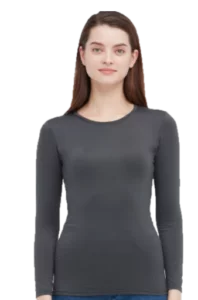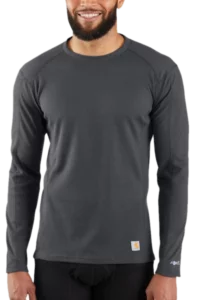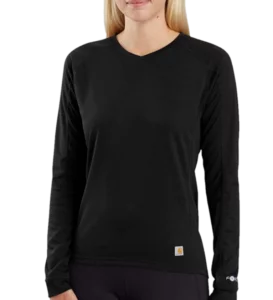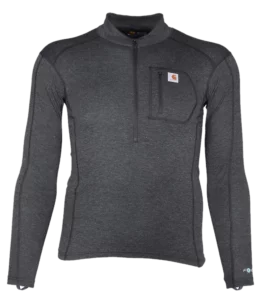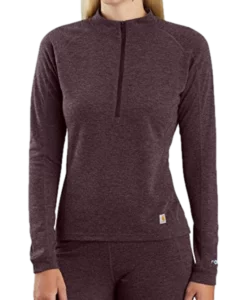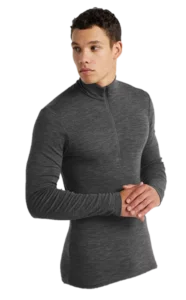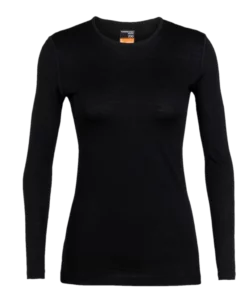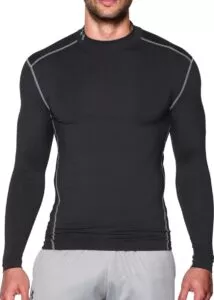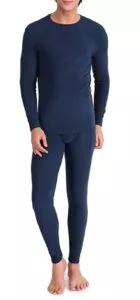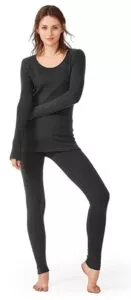
The Best Thermal Shirts in Canada
How are you planning on keeping warm this winter? If you are like me, and are looking forward to winter hobbies like skiing, skating, and hiking, a winter jacket is likely not going to be enough. So, when the thermometer dips well below zero, what is the best way to stay warm? Layering clothes is a strong option, however when physical activity, work, or staying out for long period of time is involved, you will need clothing that is designed to keep you warm and dry. This where base layers, aka thermal shirts, or waffles shirts, come in. These are layers designed to go under other layers, giving you a truly warm, dry, and comfortable starting point to keep you warm for hours.
Below, you will find our top picks for the best thermal shirts for Canada’s winters.
Our top picks
What to look for in a thermal shirt
- Fit – With any type of garment, the fit will be hugely influential in how comfortable the garment is. But with thermal garments, fit also determines the extent that the article will be able to keep you warm for a long time. The snugger the fit, the less likely the warmth created by your body will escape. Ideally, the fit you will want to look for is snug and skin-tight, without chaffing or reducing blood flow. It might be hard to determine the sweet spot between these two sides when shopping online, so we paid close attention to how users found the shirts fit and reported these findings for each thermal shirt we reviewed.
- Material – The material of a thermal layer is highly-important, impacting almost every facet of how the thermal shirt will work. Obviously, the warmth of the shirt relies on the material, but how tightly spun the material is and the type of material are both important aspects. Aspects like comfort are heavily influenced by different aspects of the material as well. Is the material elastic to accommodate activity and movement? Does the material feel nice against the skin, or will it chafe in use? Does it wick moisture away from your body?
- Mobility – As Canadians, I feel as if it is safe to say that we have all been so bundled up at one point that we could barely move. Winters feeling like the Michelin Man were all too common when I was growing up. Thermal layers are designed to improve warmth and comfort while making your winter attire overall lighter and less bulky. To fit this end, we think a thermal layer that is non-restricting and easily movable is essential. Many thermal garments include elastic materials or components to improve this.
- Construction – How is the base layer put together? This can be a huge aspect in how comfortable the base layer will be. For example, look into base layers that feature flat seams and tagless labels if you are prone to chaffing. If you need a base layer for physical activity, look for a base layer with flexible stretching.
- Moisture wicking – You have likely worked up a sweat during the winter if you are reading an article about the best thermal shirts. Or if you are not, maybe you are about to. Regardless, sweat and moisture can be real enemies of warmth during the winter, so if you are looking to hit the hills, trails or ice this winter, consider a thermal shirt with strong moisture wicking properties. Moisture wicking means it pulls moisture away from your skin and will reduce moisture or the icky dampness that can accumulate underneath all your layers. Wool, and in particular, Merino Wool, is a natural material known for its moisture wicking properties, but many synthetic materials are strong in this regard.
- Thickness – Thickness is usually discussed in terms of weight. Your use and expected climate will heavily Influence which weight or thickness you should opt for. A thinner, lightweight thermal layer will be better for moderate temperatures, with midweight and heavyweight thermals adding more warmth in return for more weight.
The Best Lightweight thermal layer
Uniqlo Heattech Crew Neck T-Shirt
Uniqlo is a Japanese retailer that crafts clothing for all styles and locations. Out of the base layers we researched, Uniqlo’s HEATTECH is the best lightweight thermal layer, for both men and women. It is thin, warm, moisture wicking, comfortable, and best of all, affordable.
Uniqlo’s HEATTECH base layers are made with a blend of synthetic fabrics, which on the standard HEATTECH consists of approximately 40% Polyester, 30% Acrylic, 20% Rayon and 10% Spandex, with different ratios between the men’s and women’s versions. These entirely synthetic blends allow for strong heat retention and moisture wicking, while keeping the materials thin and lightweight. There are many different features that this combination of materials allows for, including odor control, anti-static, and quick-drying performance.
The Uniqlo thermal layer is thin, lightweight, stretchy, and soft makes wearing this thermal layer comfy, no matter what goes on top. Best of all, you do not need to worry about washing this base layer, as it is easily machine washable and dryer safe – however for the longevity of style and fit, it is still recommended to line dry.
Overall, users are big fans of this base layer. While it is not the warmest base layer, it is a great choice for lightweight layering when you are not expecting to spend extensive lengths of time in cold conditions.
Pros
- Strong moisture wicking, anti-bacterial odor protection, and anti-static technology.
- Snug fitting without restricting your movement.
- Inexpensive for the quality offered.
Cons
- Not the warmest base layer.
The Best Midweight thermal layer
Carhartt Base Force Midweight
Carhartt is a well-respected name in workwear and now fashion. With this reputation, you know you can trust Carhartt for activewear. The Carhartt Base Force thermal layer is a strong choice, and anyone can use the midweight Base force as a versatile layer to help warm them up this winter.
The Carhartt Midweight Base Force is a waffle shirt, meaning it features raised fabric in a rectangular pattern, which aids in trapping heat inside your shirt, keeping you warmer for longer. Constructed from 100% polyester, this shirt, this shirt has strong moisture wicking and is soft and comfortable. Rugged Flex technology makes this shirt flexible and non-restrictive, although this shirt does not fit as tight as some other types of thermal shirt. The material also has strong odor resistance, so you can take this out a few trips onto the ski hill before you must wash it. Weighing between 153 to 204 grams, this base layer is lightweight but thick enough to provide solid warmth.
The Carhartt Base Force is easy to take care of since it is machine washable, but after machine drying, some users have noticed that these shirts collected “little fuzzy elements along the seam lines” or began to pill after many cycles.
Overall, users were fans of this thermal shirt, finding that the Carhartt name lives up to its quality. Users typically said that the shirts were warm and comfortable. However, there are some criticisms regarding these thermal shirts. Users who left negative views tended to find that the shirts were too snug or just straight up too small. If you can, we highly recommend referring to a size guide from Carhartt, as assuming you will take the same size in a thermal shirt than a T-shirt might be a mistake.
Pros
- Warm and comfortable.
- Strong moisture wicking, with anti-odor technology.
Cons
- Sizing is not very intuitive, so it is highly recommended to measure yourself before purchasing.
- Machine drying may alter look or structure of this garment after many cycles.
The best heavyweight thermal layer
Carhartt Base Force Heavyweight Quarter-Zip
Like the previous version of the Carhartt Base Force on this list, the Heavyweight Quarter-Zip is a strong thermal layer. Designed for those coldest days, the Heavyweight is a versatile and truly warm layer for extensive winter activities and cold days.
Unlike thinner versions of the other Base Force thermal layers, this shirt features a smooth texture instead of the “waffle texture” common among some thermal shirts. This Carhartt Heavyweight base layer is made from a blend of Polyester (80-81%) and Wool (19-20%), which combines for a soft feel, excellent moisture wicking, and toasty warmth. With smooth flat lock seams and tagless labels, this layer can be worn against bare skin underneath layers, or like a thinner sweater. Rugged flex technology makes movement in this base layer easy and non-restrictive.
The construction provides enough warmth to make it a strong choice for those who love winter activities. But the Heavyweight base force has plenty of other features that make for an excellent choice for outdoorsy types. Thumb loops located in the sleeves prevents bunching up of the sleeves under all your layers. The quarter-zip makes this easy to add ventilation when needed, and the pocket, while unique for a base layer, can be helpful. Like other Base Force base layers, the Carhartt Heavyweight is machine wash.
Overall, users found this a very warm, comfortable base layer for cold weather. While most base layers run snug and small in terms of size (so you should still use a size chart), the heavyweight Base Force thermal layer is still one you should consider going a size up to ensure it fits properly.
Pros
- Warm, comfortable base layer made from Polyester and Wool.
- Strong moisture wicking.
- Features a quarter zipper and a zippered pocket.
Cons
- Sizing is not intuitive, and you should double check the size you will need.
Under Armour ColdGear Compression Mock Long Sleeve T-Shirt
If you are looking for a thermal shirt designed for activity in cold weather, the Under Armour ColdGear is an excellent choice, due to its compression fit and quality materials.
Despite its compression fit, this UA thermal layer is non-restricting, due to 4-way stretch built-in to the shirt. Constructed from a blend of Polyester (87%) and Elastain (13%), the Under Armour ColdGear Thermal shirt features strong moisture wicking, so you will never feel moist or clammy with this thermal shirt under your layers. With a “soft-to-the skin” lining, not only is this thermal shirt highly comfortable, but designed to prevent discomfort developing with chafe-free flatlock seams. However, users have criticized the anti-odor technology use in this shirt, with odor developing just after one day. Taking care of this thermal shirt is easy since it is machine washable.
Users typically found this thermal shirt was warm and comfortable for their winter use. However, there are a few flaws that users discussed. Users have stated that the sizing of these shirts run very small, so we recommend double checking with Under Armor’s sizing guide and when in doubt, go a size up. Additionally, this thermal shirt can get hot if worn inside (or in the chalet). All-in-all, we think.
Pros
- Polyester/Elastain blend make this fit snuggly and comfortably to your body.
- Strong moisture wicking.
- Flatlock seems prevent rubbing and chaffing when you are on the road.
Cons
- Many users found that this thermal shirt is sized small and so you need to double check your size before buying.
Icebreaker Merino 175 Everyday Long Sleeve Base Layer
Merino wool is a personal favourite material – it is a natural, renewable fibre that has impressive natural qualities in thermal retention, odor control, and smooth softness, making for an impressive material for athletic and thermal uses. Icebreaker Merino is one of the top names in terms of Merino products, and these base layers are strong for winter athletic uses.
These base layers are constructed out of 100% merino, which is treated in a way to extend the lifespan of the layer. The result is a supremely soft, supremely warm base layer. Since Icebreaker uses only Merino fabrics, you get much of the benefits Merino provides: it is breathable in warmer conditions, warm in colder conditions, with excellent thermal retention, even when damp. It also has strong odor controlling properties, which makes it very popular among backpackers and other endurance athletes.
In the links we’ve provided, the men’s version features a quarterzip, and the women’s version does not, however each version is available for both men and women’s sizes.
Users are typically huge fans of Icebreaker’s Merino base layers. These shirts are known for their superior feel, performance when both dry and damp, and the odor reduction. We also really respect Icebreaker’s use of cruelty-free wool in their garments. However, before committing to Icebreaker, you should consider some of the downsides of this material. While these garments are machine washable, it is highly advisable that you strictly air dry – this will stop holes developing and keep the base layer in its optimal condition for longer.
Pros
- Strong breathability and moisture wicking for excellent athletic performance.
- Super soft, non-itchy fit.
- Uses New Zealand Merino, which is some of the most ethical wool in the world.
Cons
- Not advisable you air dry for long-term use.
Best thermal shirt and pants combo for men
David Archy Men’s Warm Base Layer Top & Bottom Thermal Set
If you are looking for a cozy, comfortable, and stylish base layer set for full body warmth, we think this set from David Archy is a strong choice. Fleece lined and super comfortable, this combo provides full body warmth.
This base layer is close fitting yet not tight. The David Archy thermal set features thick, fleecy material consisting of a blend of Acrylic, Rayon & Spandex, this set features the elasticity and moisture wicking properties these synthetic materials can provide, without the itch of wool.
This base layer set features doubled layered knee and elbow panels, adding warmth and softness to your joints. The thermal bottoms feature a functional fly, making this base layer a solid opportunity
Users have been generally impressed with this base layer set, finding both the top and bottoms soft, fleecy, and super comfortable. Some users did not find that these thermal layers lacked in the warmth aspect, while others found these thermal shirts toasty. Since there is some degree of disagreement, we have our doubts that this thermal layer is warm enough for the lowest temperatures of Canada’s winters, making this less ideal for winter activities or working outside for longer periods.
Pros
- Soft, fleecy comfort.
- Full set allows you to stay warm in style and comfort.
Cons
- Not the warmest thermal base layer.
Best thermal shirt and pants combo for women
Femofit Women’s Modal & Acrylic Thermal Set
If you are looking for nice fitting, comfortable base layer set, this set from Femofit fits that description. This thermal set might not be the warmest, but for some extra layering without discomfort, then this is a strong thermal set for you.
These Femofit thermals are snug fitting without being too tight. The Femofit features a ribbed pattern. With an entirely synthetic construction, the Femofit thermal set is constructed out of 63% Acrylic, 28% Modal, 7% Polyamide and 2% Spandex. This results in excellent heat-retention, moisture wicking, and form fitting qualities of this thermal set. Since this thermal set is constructed out of synthetic materials, it has elasticity, so you do not feel restricted while wearing this base layer.
Users were overall very happy with what they got with this Femofit thermal set. Users found that this set met every expectation that they had: it fit snugs and comfy, it wicks moisture well, and accurate fitting size. While this set is warm, users reported that this is not designed for long term use in cold weather, like Canadian conditions. This will be a great set for walking to work and will work with other layers for skiing or other activities, but you might want to consider a thicker thermal layer if you will be working outside or spending long days on the hill.
Pros
- Strong moisture wicking.
- Fits snuggly and comfortably, without worrying about ordering a size up (for most people).
- Not very expensive.
Cons
- Not the warmest thermal set.
Our Methodology
When looking for a thermal layer, what is most important is that layer keeps you warm and dry. This is highly dependent on the material of the shirt. You should look into a layer that consists of wool, synthetic materials such as rayon, polyester or acrylic, or a blend of these materials. Cotton should be avoided at all costs: cotton has virtually no moisture wicking properties, so your layer will hold onto moisture like sweat and in the process, cool you down instead of warming you up.
The next biggest consideration is the fit of the garment. Is the base layer thin so you can put multiple layers over top, or thick enough for strong thermal performance? How does the thermal layer fit? Is it restrictive, or do you have a full range of movement while wearing it?
We put over 20 hours researching different base layers. We only considered base layers that had an average score of 4 stars or higher and fit the optimal criteria we established above.
Common questions about thermal shirts
What is a thermal shirt?
Thermal shirts are another name for a thermal layer designed for your torso.
How to wear a thermal shirt?
Thermal shirts, base layers, and other kinds of thermal underwear are typically designed to be worn under all your other layers, often against bare skin.
What are the benefits of thermal shirts?
Thermal shirts do a lot more for your long-term warmth than just throwing on another layer (although we always recommend layering up adequately for the weather). They are thinner, making layering much more comfortable; they are highly breathable and movable; they keep more of your thermal energy in against your skin to keep you warmer, longer.
What material is best for a thermal shirt?
Typically, the best material will be wool, a synthetic material like polyester, spandex or nylon, or a combination. These types of materials have heat retention and moisture wicking properties that make them ideal candidates. Other materials like cotton should be avoided due to their water retention.
Typically, synthetics seem to be more favoured due to the price of the product and how they feel. Some people find wool scratchy to wear and uncomfortable. High end wools like Merino can be expensive.
How should a thermal shirt fit?
Tight, against the skin as to not let heat out, while not restricting movement or blood flow.
How often should I wash a thermal shirt?
We would read any instructions included with your thermal apparel before washing to ensure you wash it correctly. However, we should mention that many thermal shirts do have “anti-odour” technology that minimizes the smell you might create after a full day shredding powder. So go ahead, wear that thermal layer throughout your whole ski holiday! (Just change out of it for dinner).
Read more

The Best Ski and Snowboard Helmets in Canada
With winter in full swing, it’s the perfect time to go skiing or snowboarding.
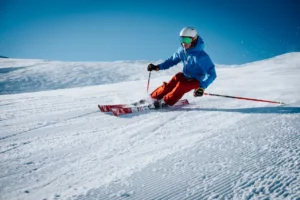
What to Carry on the Hills: A Skiing and Snowboarding Guide
Whether you are a weathered alpinist or new to the slopes, we are here to help you find the ski and snowboard gear you need.

The Best Balaclavas and Neck Gaiters in Canada
Whether looking for a balaclava or a neck gaiter, we got the best for the ski hill.

The Best Sleds In Canada This Winter
Have fun and safe ride down snowy slopes with best tubes, toboggans, and other types of sleds.
